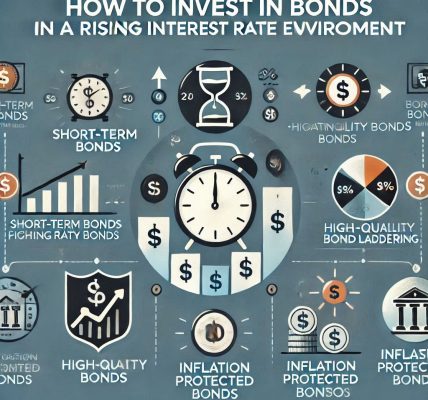In today’s unpredictable financial landscape, market volatility is a concern for investors looking to protect their hard-earned money. While stocks are often seen as the go-to investment for growth, they come with a high degree of risk, especially during periods of market turbulence. This is where bonds can play a crucial role in your investment strategy. By adding bonds to your portfolio, you can reduce risk and provide stability in times of market fluctuations.
In this blog, we’ll explore how bonds can help protect your portfolio against market volatility, the different types of bonds to consider, and strategies for using bonds as a defensive tool in your investment plan.
Why Bonds Are a Safe Haven During Market Volatility
Bonds are often referred to as a safe haven investment, especially during times of market uncertainty. Unlike stocks, which can experience sharp declines during market corrections, bonds tend to be more stable and less sensitive to short-term market fluctuations. Here’s why bonds can help protect against market volatility:
- Lower Volatility: Bonds are generally less volatile than stocks. While stock prices can swing wildly based on economic news, company performance, and investor sentiment, bond prices tend to be more stable over the long term.
- Predictable Income: Bonds provide regular interest payments (coupons) to investors, which can offer a consistent stream of income, even during volatile periods. This makes bonds an attractive option for conservative investors seeking stability.
- Capital Preservation: Bonds, particularly high-quality government bonds, offer greater capital preservation compared to stocks. When held to maturity, most bonds return your initial investment (principal), helping to shield you from market downturns.
- Inverse Relationship with Stocks: In times of market stress, bond prices often rise as investors seek safer assets. This is because bond prices tend to move inversely to stock prices. When stock markets fall, demand for bonds increases, driving up their prices and providing a hedge against stock market losses.
Types of Bonds That Offer Protection Against Volatility
Not all bonds are created equal. Different types of bonds have varying degrees of risk and return potential. When looking to protect your portfolio from market volatility, it’s essential to choose the right type of bonds based on your risk tolerance and investment goals. Here are some types of bonds that can help protect against market volatility:
1. U.S. Treasury Bonds (Government Bonds)
U.S. Treasury bonds are considered one of the safest investments due to the full backing of the U.S. government. They are highly liquid, low-risk, and offer a predictable income stream. In times of market turmoil, investors often flock to Treasury bonds, driving up their prices and providing a hedge against equity losses. These bonds are an excellent option for conservative investors seeking stability.
2. Municipal Bonds
Municipal bonds are issued by state and local governments to fund public projects. They are generally considered safer than corporate bonds because they are backed by the taxing power of the issuing entity. Municipal bonds also offer the benefit of tax-exempt income, which can be particularly appealing for high-income investors. In periods of market volatility, municipal bonds provide a stable income source while offering some tax advantages.
3. Corporate Bonds (Investment Grade)
Investment-grade corporate bonds, issued by financially stable companies, offer higher yields than government bonds while maintaining a relatively low level of risk. These bonds can help diversify your portfolio while still providing protection against volatility. Keep in mind, however, that the safety of corporate bonds depends on the financial health of the issuing company. It’s important to choose bonds from companies with strong credit ratings (AAA to BBB).
4. Inflation-Protected Bonds (TIPS)
Treasury Inflation-Protected Securities (TIPS) are designed to protect investors from inflation. They adjust in value based on changes in the Consumer Price Index (CPI), ensuring that your bond investment keeps pace with inflation. During periods of economic uncertainty, inflation may rise, and TIPS can provide a hedge against rising prices while still offering the safety of U.S. government bonds.
Strategies for Using Bonds to Protect Against Market Volatility
Now that you know how bonds can help protect your portfolio, here are some strategies to effectively incorporate bonds into your investment plan:
1. Build a Bond Ladder
A bond ladder is a strategy where you invest in bonds with varying maturities. This approach allows you to manage interest rate risk and ensures that you have bonds maturing at regular intervals. During market volatility, having a bond ladder in place can provide a steady stream of income as bonds mature, which you can reinvest or use to fund your expenses. Additionally, this strategy reduces the risk of reinvesting all your money in a single bond or interest rate environment.
2. Diversify Your Bond Portfolio
As with any investment, diversification is key to managing risk. Rather than putting all your money into a single type of bond, consider spreading your investments across different categories, such as U.S. Treasury bonds, municipal bonds, and investment-grade corporate bonds. This will help reduce the impact of any individual bond’s poor performance on your overall portfolio.
3. Maintain a Balanced Portfolio
Bonds should not make up your entire investment portfolio, especially if you’re aiming for long-term growth. However, having a sufficient allocation to bonds can help reduce volatility and protect your portfolio during market downturns. A balanced portfolio with a mix of stocks, bonds, and other asset classes allows you to benefit from the growth potential of stocks while maintaining the stability and income-producing benefits of bonds.
4. Use Bonds as a Hedge During Equity Market Drops
During periods of market downturns or heightened volatility, bonds can serve as a hedge against stock market declines. By allocating more of your portfolio to bonds during uncertain times, you can help protect your assets from the worst of market drops. Many investors increase their bond allocations during times of economic uncertainty to maintain stability and reduce risk.
5. Monitor Interest Rates and Inflation
Interest rates and inflation are key factors that affect bond prices. When interest rates rise, bond prices generally fall, and vice versa. Monitoring these factors allows you to adjust your bond holdings as needed to minimize risk and protect your investments. For example, if you expect interest rates to rise, you may want to shorten the duration of your bond portfolio by investing in shorter-term bonds, which are less sensitive to interest rate changes.
Conclusion
Bonds are a powerful tool for protecting your investment portfolio against market volatility. They offer lower risk, predictable income, and can help stabilize your portfolio when stock markets are fluctuating. By carefully selecting the right types of bonds—such as U.S. Treasury bonds, municipal bonds, or corporate bonds—and employing strategies like bond ladders and diversification, you can enhance your financial security during times of market uncertainty.


